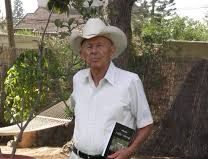Jacob’s Life Story
Jacob was born in 1930 in Romania.
He immigrated to Israel in 1946 and was educated at Kibbutz Givat Hashlosha. He participated in the War of Independence as a member of the Negev Brigade and was among the founders of the kibbutzim Be’eri and Beit Guvrin, where he gained his agricultural experience. In 1954, he began studying agriculture at the Hebrew University, earning a Master’s degree in 1959. That same year, he was employed at the Gilat Experimental Station, the southern branch of the Agricultural Research Organization, where he was responsible for field crop research in the region. Jacob was the first resident researcher at the Gilat station and remained connected to the station until his retirement.
Scientific Achievements
Jacob conducted experiments in the agronomy of peanuts and wheat, with a particular focus on optimizing water regimes and determining fertilization based on leaf diagnosis.
In 1962, he was sent to Burma by the Ministry of Foreign Affairs as part of a joint project, where he assisted in solving local wheat cultivation challenges. In 1968, he was awarded a Doctorate by the Hebrew University for his research on nitrogen metabolism in wheat leaves. During his post-doctoral sabbatical at Purdue University in the United States (1969-1971), he researched the conversion of sugar to starch in stored potato tubers. His findings led to a patent that was applied in the U.S. food industry. Upon returning to Gilat, he initiated a series of long-term experiments to thoroughly examine the factors influencing cereal cultivation in the Negev region. As a result, a new no-till technology was developed, allowing for improved water management while mitigating soil evaporation. This approach also addressed sanitation issues, erosion damage, and the loss of organic matter in the loess soils of the Negev. Implementing this method increased wheat yields by nearly 50% and provided an economic solution to the drought problem in the Negev. Based on long-term experimental data, Dr. Amir and Professor Sinclair from the University of Florida, USA, developed a mathematical model for predicting wheat yields. Dr. Amir also spearheaded the development of a biological method for predicting nitrogen and phosphorus availability in the soil, known as the “Gilat Method,” which is applied to most wheat fields in the Negev.
Dr. Jacob Amir received the Cohen Prize (1982) and was named “Researcher of the Year” by the Agricultural Research Administration (1983). He published around 80 scientific articles and was recognized as an international expert in desert agriculture, serving as an advisor in this field to many countries.
He was a member of the management of the Gilat Experimental Station and Chairman of the Ramat Negev R&D Center (1976-1981).
Retirement
Jacob retired in 1995.
— Volcani Institute —
תולדות חיים
יעקב נולד ב- 1930 ברומניה.
עלה ארצה ב-1946. התחנך בקיבוץ גבעת השלושה , השתתף במלחמת העצמאות בחטיבת הנגב והיה בין מקימי הקיבוצים בארי ובית גוברין, שם רכש את נסיונו החקלאי.
ב-1954 התחיל לימודי חקלאות באוניברסיטה העברית, וקיבל תואר מוסמך ב-1959. באותה השנה התקבל לעבודה בתחנת הניסויים גילת, התחנה הדרומית של התחנה לחקר החקלאות, כאחראי למחקר בגדולי שדה באזור.
הוא היה חוקר- תושב ראשון של תחנת גילת, ונשאר קשור לתחנה עד ליציאתו לגימלאות.
הישגים מדעיים
יעקב עסק בניסויים באגרוטכניקה של אגוזי-אדמה וחיטה, עם דגש מיוחד על יעול משטר המים וקביעת הדישון על-פי דיאגנוזה של העלים.
ב-1962 נשלח מטעם משרד החוץ לבורמה במסגרת פרויקט משותף ועזר בפתרון בעיות גידול החיטה במקום.
ב-1968 הוענק לו התואר דוקטור מטעם האוניברסיטה העברית, עבור מחקר על מטבוליזם החנקן בעלי החיטה.
בשבתון פוסט-דוקטורט באוניברסיטת פורדיו בארה”ב (1969-1971) חקר את הפיכת הסוכר לעמילן בפקעות תפוחי-אדמה באיחסון וממצאיו הניבו פטנט אשר יושם בתעשיית המזון בארה”ב.
עם שובו לגילת, החל בסידרה של ניסויים רב-שנתיים כדי לבחון ביסודיות את גורמי גידול הפלחה באזור הנגב. כתוצאה, פותחה טכנולוגיה חדשה של אי-פליחה המאפשרת שיפור משטר המים תוך כדי ניטרול תהליך האידוי מהקרקע. ממשק זה גם פותר את בעיות התברואה, נזקי הסחף ואיבוד החומר האורגני בקרקעות הלס בנגב. הפעלת השיטה העלתה את יבולי החיטה בקרוב ל-50% ומהווה פתרון כלכלי לבעיית הבצורת בנגב. על בסיס נתונים של ניסויים ארוכי-טווח בנו ד”ר עמיר ופרופ’ סנקלר מאוניברסיטת פלורידה בארה”ב מודל מתמטי המאפשר חיזוי יבולי החיטה.
ביוזמתו של ד”ר עמיר גם פותחה שיטה ביולוגית לחיזוי זמינות החנקן והזרחן בקרקע, והיא מקובלת בשם “שיטת גילת” ומיושמת ברוב שטחי החיטה בנגב.
ד”ר יעקב עמיר קיבל “פרס כהן” (1982) ונבחר ל “חוקר השנה” במינהל המחקר החקלאי (1983).
פירסם כ-80 מאמרים מדעיים.
הוא נחשב למומחה בין-לאומי בנושא חקלאות מדברית ושימש כיועץ בתחום זה למדינות רבות.
היה חבר הנהלת תחנת הניסויים גילת ויו”ר מו”פ רמת הנגב (1976-1981).
הפרישה לגמלאות
פרש לגימלאות ב-1995.
** מתוך מכון וולקני
1. 1959-1963: Agronomic and physiological research of peanut
in loessial soil in the Negev Desert Region in Israel.
2. Biological method for evaluating soil nitrogen, phosphorus and cereal
nematodes infestation in the loessial soil in the Negev de
3. New technology for achieving economical yields of cereal in drought
years in the Negev desert.
4. Mechanistic model describing growth and yield of wheat under water limitation
and irrigation conditions.
5.Control of starch – sugar conversion in plants.
Enzimology Field Crops.
Agricultural Sciences
Natural Resource Management
1959 M.Sc. Degree: The Hebrew University of Jerusalem – Fieldcrops
1968: Ph.D. Degree – The Hebrew University of Jerusalem – Biochemistry
1. 1982-A.2. Cohen prize for contribution to plant protection
2. 1983 – Researcher of the year, Agricultural Res. Organization
3. American society of agronom membership
4. American society of plant physiology membership
5. Israel society of botany membership.
1. 1949-1953: Kibbutz manager
2.1959-1996: Research scientist (ARO) Volcani Center, Gilat experiment station.
3.1961-1963: Advisor to the government of Burma, Director of research in wheat project at Namsang
4. 1972-1974: Chief of research, Gilat experiment station
5.1976-1980: Chairman, Executive Board, Ramat Hanegev
